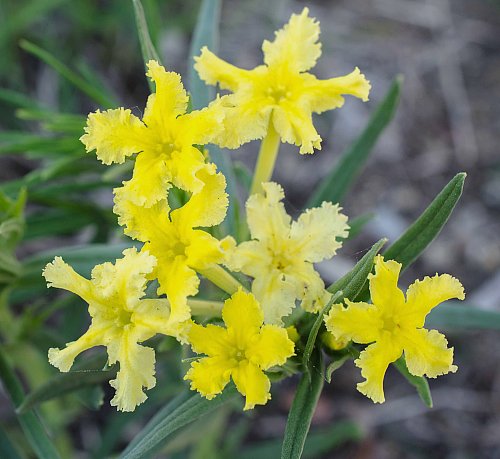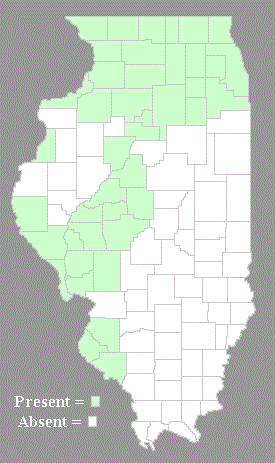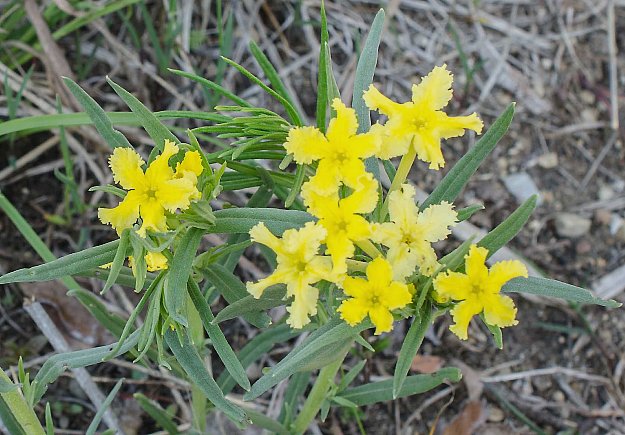
Each mature stem terminates in a cluster of nearly sessile flowers. Each flower consists of a pale yellow to yellow corolla, a whitish green calyx with 5 linear teeth, 5 inserted stamens, and a pistil with a single style. The trumpet-shaped corolla is ¾–1¼" (18-32 mm.) long and 10-18 mm. across; it has 5 rounded spreading lobes, a narrowly cylindrical base, and a throat with a narrow opening. The lobes of the corolla are ruffled or fringed. The calyx (including its teeth) is up to 8 mm. long; it is more or less covered with appressed hairs. At the flower bases, there are small leafy bracts up to 8 mm. long; except for their small size, they resemble the leaves. The blooming period for these flowers occurs from late spring to early summer, lasting about 3 weeks. In addition to these showy flowers, this plant also produces small cleistogamous flowers later in the summer. These latter flowers are about ¼" long and inconspicuous; they are self-fertile. Afterwards, fertile flowers are replaced by small nutlets (4 nutlets per flower). Mature nutlets are 3–3.5 mm. long, ovoid in shape, light gray to white, shiny, and sparsely pitted. Individual nutlets are keeled along one side, while their bottoms are truncate and their apices are somewhat pointed. The root system consists
 of a deep taproot. This
plant reproduces by reseeding itself.
of a deep taproot. This
plant reproduces by reseeding itself.Cultivation: The preference is full sun, dry-mesic to dry conditions, and barren soil that is stony or sandy. Seed germination requires no pretreatment involving winter dormancy. As a perennial, this plant is moderately short-lived (typically surviving about 5 years), but its seeds are easier to germinate than many other native puccoons (Lithospermum spp.).
Range & Habitat: The native Fringed Puccoon occurs in northern and western Illinois, where it is uncommon. Illinois lies along the eastern range-limit of this species. Habitats include upland prairies, gravel prairies, sand prairies, hill prairies, sandy or rocky savannas, limestone glades, and pastures. Fringed Puccoon has a tendency to increase in response to light or moderate grazing by cattle. Occasional wildfires are probably beneficial by reducing competition from woody plants and by removing the accumulation of smothering debris from dead herbaceous plants. In Illinois, Fringed Puccoon is found in higher quality natural areas.
Faunal Associations: The structure of the large showy flowers indicates that they are cross-pollinated by butterflies, skippers, and possibly the Ruby-throated Hummingbird (in Illinois). A small number of insects are known to feed on the leaves, roots, and other parts of Fringed Puccoon and other puccoons (Lithospermum spp.) that are found in prairies. They include larvae of a long-horned beetle (Hemierana marginata ardens), larvae of a moth, the Gray Ethmia (Ethmia monticola fuscipedella), and larvae of a Sesiid moth (Carmenta mariona); see Yanega (1996), Powell (1973), and BugGuide (at bugguide.net) for more information. However, the range of the Sesiid moth extends eastward to Kansas and Nebraska; it has not been found in Illinois. Several polyphagous grasshoppers are known to feed occasionally on Fringed Puccoon. They include the Two-striped Grasshopper (Melanoplus bivittatus), Red-legged Grasshopper (Melanoplus femurrubrum), Yellowish Grasshopper (Melanoplus flavidus), and Gladston's Grasshopper (Melanoplus gladstoni); see Campbell et al. (1974), Brust et al. (2008), and Joern (1985) for more information.

Photographic Location: A sandy hill prairie in Cook County, Illinois. The photographs were taken by Bill Johnson (Copyright © 2014).
Comments: This is one of three puccoon species (Lithospermum spp.) in Illinois that inhabit prairies. They all produce showy flowers at about the same time each year that vary in color from pale yellow to orange-yellow. Fringed Puccoon can be distinguished from these other species by the fringed or ruffled lobes of its corolla and very narrow leaves (2-6 mm. across). It also produces small cleistogamous (self-fertile) flowers, unlike the others. Similar to other puccoons, a blue dye can be obtained from its roots.